Class X Poem -4 'How to Tell Wild Animals' by - 'Carolyn Well'
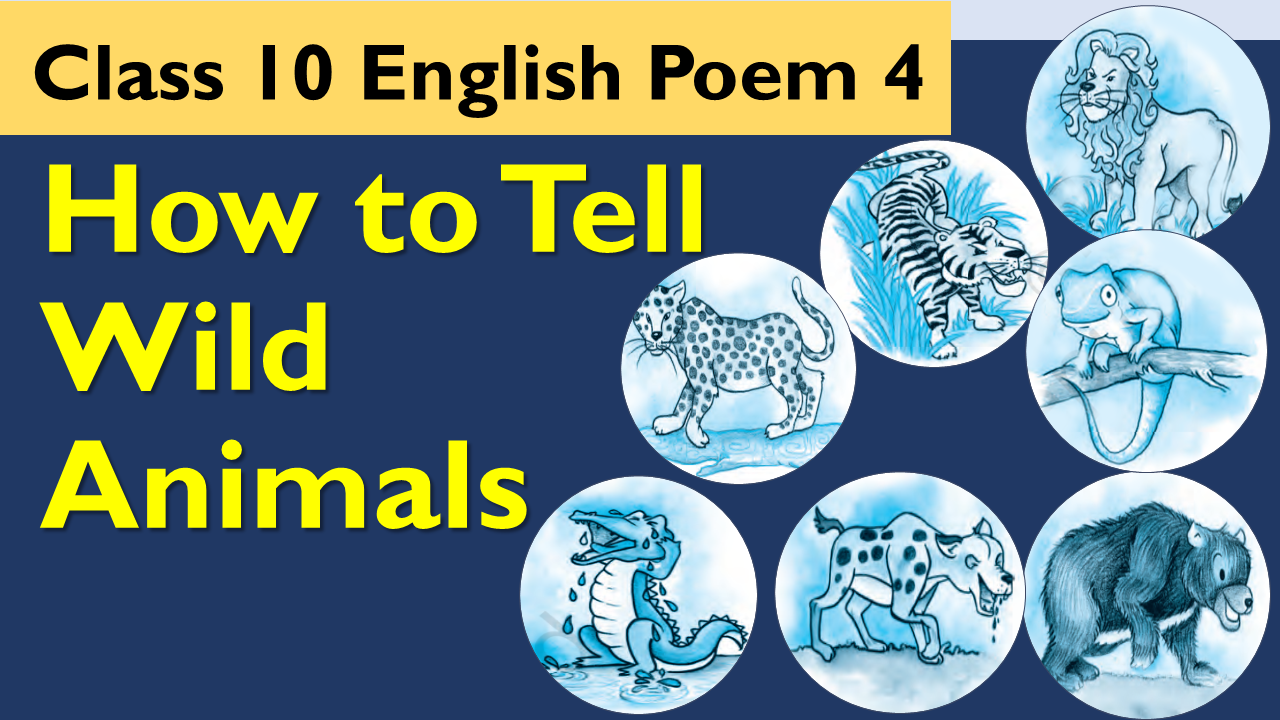
About the Poet
Carolyn Wells (1862-1942) was an American writer who was famous for books based on mystery. Her famous works are at the sign of the Sphinx (1896), The Jingle book (1899), the story of Betty (1899) etc.
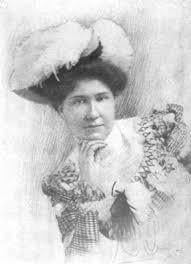
Central Idea of the Poem
The poem ‘How to Tell Wild Animals’ by Carolyn Wells revolves around the
dangerous ways to identify the wild animals. The poet tries to distinguish one
animal from the other in a humorous way. The poet suggests that its very risky
to be in such a close proximity to these wild beasts. The poem is, thus, very
educative as it tells us about various features of wild animals.
Summary of the poem
The poet is describing the various wild animals. These animals are very dangerous and she has introduced them one by one in a very funny way. First of all she tells us about an Asian lion. She says that if you are visiting the jungles of the east and there you see an animal which has tawny skin and he roars so loudly that you will die out of fear. This means that you have seen an Asian lion. Next in the line is the Bengal tiger that she has explained to be a royal animal that at once attacks and kills a man. She says by adding humour that if this beautiful black striped animal kills you and eats you, then you have surely met a Bengal tiger. After this, she says that if the reader met an animal that has black spotted skin and it at once jumps on him, then it means that the reader has met a leopard. Moreover, she says that if one will cry out in pain, it maybe of no use as the leopard will not stop attacking him. Then she moves on to the bear that she says will hug very tightly. This is the way to recognize a bear as it kills a person by hugging him very tightly. So, she says that the bear will continue to hug us tightly and that is the only way to recognize him. After this, she asks a question to the readers that do they know how to recognize beasts that hunt their prey. Here she explains about hyenas which she thinks have a smiling face and the crocodiles that have tears in their eyes. This can be seen when they are killing their prey. The last one in the list is the Chameleon. She says that it is a lizard - like creature which doesn’t have ears and wings just like a lizard. Only this can help you differentiate between a lizard and chameleon. She further says that the chameleon has a quality of changing its color according to the colour of the surface. So, to explain this she says that if the reader looks at the tree and if he can only see the tree, this means that there is a chameleon sitting on it which has already turned its color to brown just like the branch of the tree.
"TEXT OF THE POEM"
If ever you should go by chance
To jungles in the east;
And if there should to you advance
A large and tawny beast,
If he roars at you as you’re dyin’
You’ll know it is the Asian Lion...
To jungles in the east;
And if there should to you advance
A large and tawny beast,
If he roars at you as you’re dyin’
You’ll know it is the Asian Lion...
Or if some time when roaming round,
A noble wild beast greets you,
With black stripes on a yellow ground,
Just notice if he eats you.
This simple rule may help you learn
The Bengal Tiger to discern.
A noble wild beast greets you,
With black stripes on a yellow ground,
Just notice if he eats you.
This simple rule may help you learn
The Bengal Tiger to discern.
If strolling forth, a beast you view,
Whose hide with spots is peppered,
As soon as he has lept on you,
You’ll know it is the Leopard.
’Twill do no good to roar with pain,
He’ll only lep and lep again.
Whose hide with spots is peppered,
As soon as he has lept on you,
You’ll know it is the Leopard.
’Twill do no good to roar with pain,
He’ll only lep and lep again.
If when you’re walking round your yard
You meet a creature there,
Who hugs you very, very hard,
Be sure it is a Bear.
If you have any doubts, I guess
He’ll give you just one more caress.
You meet a creature there,
Who hugs you very, very hard,
Be sure it is a Bear.
If you have any doubts, I guess
He’ll give you just one more caress.
Though to distinguish beasts of prey
A novice might nonplus,
The Crocodile you always may
Tell from the Hyena thus:
Hyenas come with merry smiles;
A novice might nonplus,
The Crocodile you always may
Tell from the Hyena thus:
Hyenas come with merry smiles;
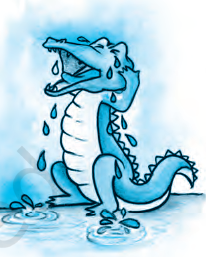
The true Chameleon is small,
A lizard sort of thing;
He hasn’t any ears at all,
And not a single wing.
If there is nothing on the tree,
’Tis the chameleon you see.
A lizard sort of thing;
He hasn’t any ears at all,
And not a single wing.
If there is nothing on the tree,
’Tis the chameleon you see.

Poem and Explanation
If ever you should go by chance
To jungles in the east;
And if there should to you advance
A large and tawny beast,
If he roars at you as you’re dyin’
You’ll know it is the Asian Lion...
WORD MEANINGS
advance – to move forward towards sb/sth, often in order to attack or threaten
tawny – brownish-yellow in colour
beast – a dangerous animal
Exp.- The poet is telling the readers that how they can recognize various animals in the jungles of the east. So, in first stanza she says that if the reader comes across an animal whose skin is yellowish brown in colour and if it roars at him so strongly that he can die out of fear, it means that he has encountered an Asian Lion. She has humorously explained the Asian Lion which could kill a person with its roar.
To jungles in the east;
And if there should to you advance
A large and tawny beast,
If he roars at you as you’re dyin’
You’ll know it is the Asian Lion...
advance – to move forward towards sb/sth, often in order to attack or threaten
tawny – brownish-yellow in colour
beast – a dangerous animal
Literary Devices
Rhyme: Rhyme scheme ababcc is followed (chance-advance, east-beast, dyin-lion)
Enjambment: Continuation of a sentence to the next line (and if there…..tawny beast)
Assonance: use of vowel sound ’o’ (you should go, should to you, roars,)
Allusion: Reference to a famous thing, place, species of animal, etc (Asian Lion)
Enjambment: Continuation of a sentence to the next line (and if there…..tawny beast)
Assonance: use of vowel sound ’o’ (you should go, should to you, roars,)
Allusion: Reference to a famous thing, place, species of animal, etc (Asian Lion)
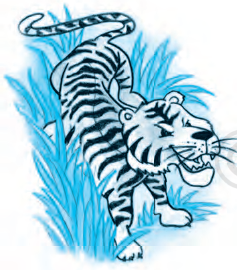
Or if some time when roaming round,
A noble wild beast greets you,
With black stripes on a yellow ground,
Just notice if he eats you.
This simple rule may help you learn
The Bengal Tiger to discern.
A noble wild beast greets you,
With black stripes on a yellow ground,
Just notice if he eats you.
This simple rule may help you learn
The Bengal Tiger to discern.
WORD MEANINGS
noble – here, very impressive in size
ground – background
discern – make out, identify
noble – here, very impressive in size
ground – background
discern – make out, identify
Exp –
She explains an animal that roams in the jungle and belongs to a royal clan. The colour of its skin is yellowish with black stripes. She says that if you notice that he kills you and eats you up, then this means that you have surely seen a Bengal Tiger. This time also she has used dark humour to explain how a tiger looks like because once a person has been eaten up by a wild animal, there is no use in determining which wild animal it is.
Literary Devices
Rhyme: Rhyme scheme ababcc is followed (round-ground, you-you learn-discern)
Alliteration: repetition of consonant sound ‘r’ at start of two or more closely connected words (roaming round)
Allusion: Reference to a famous thing, place, species of animal, etc (Bengal Tiger)
Assonance: Use of vowel sound ’o’ (or if some time when roaming round)
Alliteration: repetition of consonant sound ‘r’ at start of two or more closely connected words (roaming round)
Allusion: Reference to a famous thing, place, species of animal, etc (Bengal Tiger)
Assonance: Use of vowel sound ’o’ (or if some time when roaming round)
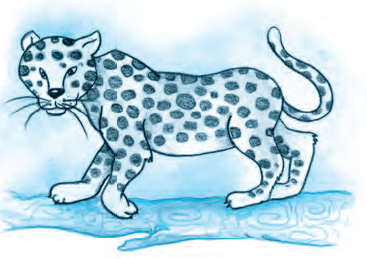
If strolling forth, a beast you view,
Whose hide with spots is peppered,
As soon as he has lept on you,
You’ll know it is the Leopard.
’Twill do no good to roar with pain,
He’ll only lep and lep again.
Whose hide with spots is peppered,
As soon as he has lept on you,
You’ll know it is the Leopard.
’Twill do no good to roar with pain,
He’ll only lep and lep again.
WORD MEANINGS
strolling – to walk somewhere in a slow relaxed way
forth – forwards, away from a place
peppered – here, covered with spots
lept (leap) – to jump high or a long way
hide – animal skin
strolling – to walk somewhere in a slow relaxed way
forth – forwards, away from a place
peppered – here, covered with spots
lept (leap) – to jump high or a long way
hide – animal skin
EXPLANATION - The poet says that if you are casually walking in a jungle, you will meet an animal who has a skin with spots on it. This animal is so fast that it will leap on you at once which means that it will jump on you. This jumping is an indication that it is none other than the Leopard. Moreover, she adds that if you will cry out in pain, it is not going to be of any use as it will keep on jumping on you. So, in this stanza the poet has explained the characteristic of a leopard.
Literary Devices
Rhyme: Rhyme scheme ababcc is followed (view- you, peppered- Leopard, pain-again)
Alliteration: use of consonant sound ‘h’ in the beginning of two words (he has)
Poetic license: A liberty to the poet to change the spellings in order to create rhyme or rhythm in a poem (use of lept instead of leapt)
Repetition: use of ‘lep’ word in the last line.
Assonance: use of vowel sound ‘o’ (strolling-forth-you, whose-spot, do no good to roar)
Alliteration: use of consonant sound ‘h’ in the beginning of two words (he has)
Poetic license: A liberty to the poet to change the spellings in order to create rhyme or rhythm in a poem (use of lept instead of leapt)
Repetition: use of ‘lep’ word in the last line.
Assonance: use of vowel sound ‘o’ (strolling-forth-you, whose-spot, do no good to roar)
Consonance: use of ‘l’ sound (he’ll only lep lep)
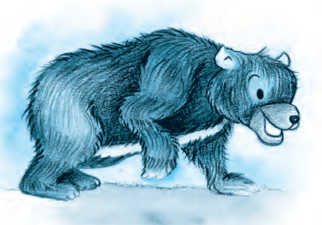
If when you’re walking round your yard
You meet a creature there,
Who hugs you very, very hard,
Be sure it is a Bear.
If you have any doubts, I guess
He’ll give you just one more caress.
You meet a creature there,
Who hugs you very, very hard,
Be sure it is a Bear.
If you have any doubts, I guess
He’ll give you just one more caress.
WORD MEANINGS
yard – a piece of land next to or around your house
caress – a gentle, loving touch
yard – a piece of land next to or around your house
caress – a gentle, loving touch
EXPLANATION - If you are walking in the lawn area of your house and you meet a creature which hugs you tightly, it is a bear. She further adds that if you are still in doubt regarding the animal, the easiest way is that he will keep hugging and touching you very gently. This act of his will make you sure about its identity. You will come to know that it is a bear.
Literary Devices
Rhyme: Rhyme scheme ababcc is followed (yard-hard, there- bear, guess-caress)
Enjambment: Continuation of a sentence to the next line (if you were walking….creature there)
Alliteration: use of ‘w’ sound (when-walking), use of ‘h’ sound (who- hugs), use of ‘b’ sound (be-bear)
Assonance: use of vowel ‘e’ (meet a creature there)
Enjambment: Continuation of a sentence to the next line (if you were walking….creature there)
Alliteration: use of ‘w’ sound (when-walking), use of ‘h’ sound (who- hugs), use of ‘b’ sound (be-bear)
Assonance: use of vowel ‘e’ (meet a creature there)
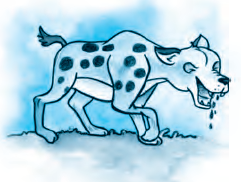
Though to distinguish beasts of prey
A novice might nonplus,
The Crocodile you always may
Tell from the Hyena thus:
Hyenas come with merry smiles;
A novice might nonplus,
The Crocodile you always may
Tell from the Hyena thus:
Hyenas come with merry smiles;

WORD MEANINGS
beasts of prey – an animal, a bird etc, that is hunted, killed or eaten by another.
novice – someone new to a job
nonplus – be puzzled, confused, surprised
beasts of prey – an animal, a bird etc, that is hunted, killed or eaten by another.
novice – someone new to a job
nonplus – be puzzled, confused, surprised
Hyena – a wild animal like a dog, that eats the meat of animals that are
already dead and has a cry like human laugh
EXP.- The poet says that for someone who is new to the job of recognizing animals, it will be like a puzzle to recognize animals that hunt other animals for their food. So here the poet tries to help out the readers by telling the difference between two animals. He says that Hyenas will be smiling whereas if it is a crocodile, it is always in tears. Both of these animals are dangerous.
Literary Devices
Rhyme: Rhyme scheme ababcc is followed (prey-may, nonplus-thus, smiles-crocodiles)
Alliteration: use of consonant sound ‘n’ (novice-nonplus), use of ‘th’ sound (the-thus)
Alliteration: use of consonant sound ‘n’ (novice-nonplus), use of ‘th’ sound (the-thus)
Enjambment: continuation of sentence to the next line (though to distinguish….might nonplus, The crocodile…..hyena thus)
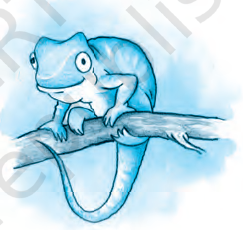
The true Chameleon is small,
A lizard sort of thing;
He hasn’t any ears at all,
And not a single wing.
If there is nothing on the tree,
’Tis the chameleon you see.
A lizard sort of thing;
He hasn’t any ears at all,
And not a single wing.
If there is nothing on the tree,
’Tis the chameleon you see.
WORD MEANING
Chameleon – a small lizard that can change colour according to its surroundings
Chameleon – a small lizard that can change colour according to its surroundings
The poet says that the next is Chameleon which is a small creature. It looks like a lizard but the difference between the two is that chameleon does not have ears and wings. Moreover she says that chameleon has the ability to change its color according to the surface on which it is sitting. Therefore, if you see a tree and find nothing else on it, then it must be a chameleon sitting on it. It has changed its colour into the color of tree.
Literary Devices
Rhyme: Rhyme scheme ababcc is followed (small-all, thing-wing, tree-see)
Alliteration: use of ‘h’ sound (he hasn’t)
Question and Answers
Alliteration: use of ‘h’ sound (he hasn’t)
Question and Answers
Q1-Does ‘dyin’ really rhyme with ‘lion’? Can you say it in such a way that it does?
ANS-The actual word is dying which does not rhyme with lion. In order to create rhyme, it is written as ‘dyin’ in the poem.
Q2- How does the poet suggest that you identify the lion and the tiger? When can you do so, according to him?
ANS-The poet differentiates between the two in the following manner-
He says that if the beast is of yellow- brown colour that is tawny colour and it roars out so fiercely that you may die out of fear, then this is an Asian lion.
Whereas, if the animal has black stripes on yellow background of hthe skin and he attacks to kill you, then it is a Bengal tiger.
Whereas, if the animal has black stripes on yellow background of hthe skin and he attacks to kill you, then it is a Bengal tiger.
Q3- Do you think the words ‘lept’ and ‘lep’ in the third stanza are spelt correctly? Why does the poet spell them like this?
ANS-The words ‘lept’ and ‘lep’ have not been spelled correctly. It is a poetic device known as poetic license which is used by the poet to lay emphasis on the actions of the leopard.
Q4- Look at the line “A novice might nonplus”. How would you write this ‘correctly’? Why is the poet’s ‘incorrect’ line better in the poem?
ANS-The correct order of the sentence is ‘a novice might be nonplussed’. The poet wrote it in order to bring rhyme to her poem. nonplus rhymes with thus.
Q5- Much of the humour in the poem arises from the way language is used, although the ideas are funny as well. If there are particular lines in the poem that you especially like, share these with the class, speaking briefly about what it is about the ideas or the language that you like or find funny?
ANS- Yes, it is true that the poet has used the language in a way that it arises humour. The poet has used many lines that are funny. One such is ‘If he roars at you as you’re dyin’.You’ll know it is the Asian Lion...’ or the other one is ‘A noble wild beast greets you’. So his idea of explaining the characteristics of the wild animals is quite funny
EXTRA QUESTION -
Short
Answer Type Questions
Question 1. Name the different animals and birds
found in the jungles of the east.
Answer: The different animals are bengal tiger,
Asians Lion, Leopard, Bear, Crocodile, Hyena, Chameleon. There is no mention of
any bird in the poem.
Question 2. What features of a bear are described in
the poem ?
Answer: The bear hugs him tightly when he sees a human being. It clasps its prey tightly with both its fore paws and brings him to death. It again holds it tightly finally killing him.
Answer: The bear hugs him tightly when he sees a human being. It clasps its prey tightly with both its fore paws and brings him to death. It again holds it tightly finally killing him.
Question 3. How can you differentiate between a
tiger and a leopard ?
Answer: A tiger has black stripes on its yellow coloured coat, but a leopard has spots on its body. A tiger kills its prey to satisfy its’ hunger, whereas a leopard can even kill for pleasure.
Answer: A tiger has black stripes on its yellow coloured coat, but a leopard has spots on its body. A tiger kills its prey to satisfy its’ hunger, whereas a leopard can even kill for pleasure.
Question 4. What is the brief summary of the poem ?
Answer: The poet tries to distinguish different animals in a humorous manner. He is also educating by describing the various features of wild animals.
Answer: The poet tries to distinguish different animals in a humorous manner. He is also educating by describing the various features of wild animals.
Question 5. How can you identify the Asian lion and
the Bengal Tiger?
Answer: The Asian Lion has a large body and a brownish-yellow
coat. It roars loudly when it attacks it’s prey. On the other hand, the Bengal Tiger has black stripes on its yellow coat. It silendy attacks it’s prey.
Answer: The Asian Lion has a large body and a brownish-yellow
coat. It roars loudly when it attacks it’s prey. On the other hand, the Bengal Tiger has black stripes on its yellow coat. It silendy attacks it’s prey.
Question 6. Write the sum and substance of the poem,
“How to Tell Wild Animals”.
Answer: The poet, Carolyn Wells, in the poem suggests some of the dangerous ways to identify the wild animals. The poem is full of humorous examples when the poet tries to distinguish one animal from the other. Moreover, the poem educates us by describing the various features of wild animals.
Answer: The poet, Carolyn Wells, in the poem suggests some of the dangerous ways to identify the wild animals. The poem is full of humorous examples when the poet tries to distinguish one animal from the other. Moreover, the poem educates us by describing the various features of wild animals.
Question 7. How can you distinguish between a tiger
and a leopard?
Answer: A tiger has black stripes on its yellow coat. A leopard on the other hand, does not have any stripes. It has spots peppered on its body. Moreover, a tiger kills only when it is hungry, while a leopard can kill for the pleasure of killing by pouncing continuously on its prey.
Answer: A tiger has black stripes on its yellow coat. A leopard on the other hand, does not have any stripes. It has spots peppered on its body. Moreover, a tiger kills only when it is hungry, while a leopard can kill for the pleasure of killing by pouncing continuously on its prey.
Question 8. How can you distinguish between a hyena
and a crocodile?
Answer: A hyena laughs as it swallows its victim, whereas a crocodile weeps as it swallows its victim.
Answer: A hyena laughs as it swallows its victim, whereas a crocodile weeps as it swallows its victim.
Question 9 . What are the distinctive features of the
Asian lion as given in the poem?
Answer: The Asian Lion is large in stature. It is brownish-yellow in colour. It roars very loudly. The sound of its roar is so terrible to hear that it can make one almost die due to fear. The Asian Lion is found in the forests of East Asian countries.
Answer: The Asian Lion is large in stature. It is brownish-yellow in colour. It roars very loudly. The sound of its roar is so terrible to hear that it can make one almost die due to fear. The Asian Lion is found in the forests of East Asian countries.
Question 10. What does the Bengal Tiger look like?
What is so distinct about him?
Answer: The Bengal Tiger roams freely in the forest. It is noble and majestic in stature. It wears black stripes on a yellow hide. When it notices someone it tries to eat him. The Bengal tiger attacks its prey very silently and grasps it with his terrifying teeth.
Answer: The Bengal Tiger roams freely in the forest. It is noble and majestic in stature. It wears black stripes on a yellow hide. When it notices someone it tries to eat him. The Bengal tiger attacks its prey very silently and grasps it with his terrifying teeth.
Question 11. How does a leopard behave when he sees
someone?
Answer: As leopard has black spots all over its body. As soon as it sees someone, it leaps over him at once. It keeps on pouncing continuously on its victim, attacks him and starts eating him.
Answer: As leopard has black spots all over its body. As soon as it sees someone, it leaps over him at once. It keeps on pouncing continuously on its victim, attacks him and starts eating him.
Question 12. How does the poet describe the bear?
Answer: The poet describes the bear in a humorous way. He says that as soon as a bear sees a human being, it hugs him tightly. It clasps its prey tightly with both its hands and squeezes him to death. If he is still alive, he gives him another tight hug to kill him.
Answer: The poet describes the bear in a humorous way. He says that as soon as a bear sees a human being, it hugs him tightly. It clasps its prey tightly with both its hands and squeezes him to death. If he is still alive, he gives him another tight hug to kill him.
Question 13. What is so weird about the Hyena and the
crocodile?
Answer: Some animals such as the hyena and the crocodile are famous for
their weird behaviour. For example, a laughing hyena’s voice resembles human’s
laughing sound. Moreover, a hyena laughs while swallowing it’s prey, while a
crocodile shed tears.
Question 14. Describe a few characteristics of a
chameleon.
Answer: A chameleon is a garden lizard and is an expert at camouflage. It changes its colour as per its surroundings. This ability of camouflage helps it in saving it from the hunters. A chameleon does not have – any ears or wings.
Answer: A chameleon is a garden lizard and is an expert at camouflage. It changes its colour as per its surroundings. This ability of camouflage helps it in saving it from the hunters. A chameleon does not have – any ears or wings.
Long
Answer Type Questions
Question 1. State in your own words the humour which
lies in the poem.
Answer: The poet ‘Carolyn wells’ creates humour by describing different wild animals. The poet explains the different characteristics of different animals in a very funny and interesting manner. The poet’s language refreshes the reader’s mood and makes him happy. Humour in the poem is the best medicine for every ailment in life. Humour increases our energy and decreases our pain. Thus the poem is fully a vitalizer.
Answer: The poet ‘Carolyn wells’ creates humour by describing different wild animals. The poet explains the different characteristics of different animals in a very funny and interesting manner. The poet’s language refreshes the reader’s mood and makes him happy. Humour in the poem is the best medicine for every ailment in life. Humour increases our energy and decreases our pain. Thus the poem is fully a vitalizer.
Question 2. ‘Humour is the best medicine for every
ailment in life’. Comment.
Answer: Humour is infectious. When humour is shared, it binds people together and increases happiness. Humour strengthens our immune system, boosts our energy, diminishes pain and protects us from the damaging effects of stress. It is the priceless medicine for every ailment in life. The poet, in the poem ‘How to tell Wild Animals’ creates humour by describing various beasts of prey. The way the poet explains the things is very funny yet interesting. The poet has depicted the wildlife very vividly and in a lively manner. While reading the poem, the readers enjoy the poet’s work and it leaves them refreshed and happy.
Answer: Humour is infectious. When humour is shared, it binds people together and increases happiness. Humour strengthens our immune system, boosts our energy, diminishes pain and protects us from the damaging effects of stress. It is the priceless medicine for every ailment in life. The poet, in the poem ‘How to tell Wild Animals’ creates humour by describing various beasts of prey. The way the poet explains the things is very funny yet interesting. The poet has depicted the wildlife very vividly and in a lively manner. While reading the poem, the readers enjoy the poet’s work and it leaves them refreshed and happy.

Comments
Post a Comment